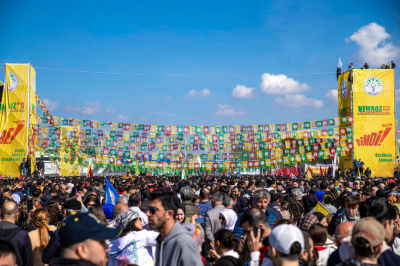What to know about Nowruz, the Persian New Year
According to Persian mythology, King Jamshid was a wise and powerful ruler who reigned over an empire known as the Pishdadian dynasty. He was a just and benevolent king who possessed great wisdom and knowledge.

One of the most famous stories about Jamshid involves his legendary flying throne, which was so magnificent that it would rise into the air, carrying the king high above his kingdom, allowing him to see and govern his lands with wisdom and justice. King Jamshid is credited with a number of achievements, including the founding of the city of Persepolis, the introduction of the solar calendar and the establishment of Nowruz as a major celebration marking the beginning of the new year.
Nowruz, also known as the Persian New Year, is the traditional Iranian festival of spring which starts at the exact moment of the vernal equinox, typically around March 20 or 21, and marks the beginning of the new year in the Persian calendar. This year, Iranians will celebrate Nowruz on Tuesday, March 19 at 10:06 p.m. (Central Daylight Time).
Observed by communities across Iran, Afghanistan, Azerbaijan, Turkey and beyond, Nowruz holds deep cultural and historical significance, dating back over 3,000 years. Nowruz, meaning "new day" in Persian, embodies themes of renewal, rebirth and the triumph of light over darkness. The celebration typically lasts for about two weeks, with the first day marked as a public holiday in many countries.
Preparing for Nowruz involves a blend of spiritual, cultural and practical activities. Families come together to usher in the new year by cleaning their homes, purchasing new clothes and preparing holiday meals. Central to the Nowruz traditions is the setting up of the Haft-Seen table, adorned with seven symbolic items starting with the letter "S" in Persian — apples, garlic, sumac, vinegar, wheat or barley sprouts, sweet pudding and dried fruit.
Some families may also participate in specific rituals and ceremonies to mark the arrival of Nowruz, such as jumping over bonfires (Chaharshanbe Suri) on the last Wednesday before Nowruz to ward off evil spirits. Overall, fire plays a central role in Nowruz celebrations, marking the transition from the dark and cold days of winter to the light and warmth of spring. It symbolizes purification, renewal, protection and the triumph of good, making it a powerful and meaningful element of the festive traditions surrounding the Persian New Year.
Over the years, Nowruz celebrations have incorporated new elements and customs influenced by different regions, cultures and historical events. For example, some modern celebrations may include fireworks, concerts, parades and other forms of entertainment that were not traditionally part of Nowruz.
Nowruz has also become more secularized in some regions, with a focus on cultural and traditional aspects rather than religious rituals. This has allowed people from diverse backgrounds to participate in and enjoy the festivities, including Christians. Iranian Christians may choose to avoid certain practices or customs associated with Nowruz that conflict with their Christian beliefs or values. For example, they may choose not to participate in rituals that involve superstitions or idolatry, similar to how many Christians in the United States celebrate New Years without invoking “Fortune” or “Luck” to grant them a good year.
While Nowruz may seem unfamiliar to some in the Western world, there are parallels with celebrations such as Easter and the spring equinox. Like Nowruz, Easter symbolizes new beginnings and the triumph of life over death, while the spring equinox marks the onset of the season of renewal. While not direct equivalents, these celebrations share common themes of hope, rebirth, and the celebration of the changing seasons.
Nowruz traditions have evolved over time, adapting to changing cultural landscapes while being preserved through community events, educational initiatives, and media outreach. Iran Alive — a ministry that broadcasts life-giving, Gospel-centric messages 24/7 into Iran — will host an online Nowruz celebration in Farsi on Tuesday, March 19 at 10:06 PM (CDT), inviting Iranians to celebrate the traditional holiday of renewal and to accept true renewal in Christ.
Christians can embrace the spirit of renewal and unity that defines this ancient celebration and share our Christian hope. May I be the first to wish you, “Nowruz Mobarak!”
Lily Meschi serves as Director of Partners Relations for Iran Alive Ministries, which broadcasts a 24/7 Satellite channel into the Middle East and Central Asia with 130 million potential viewers. In addition to broadcasting, Iran Alive has planted one of the largest underground church networks inside Iran. It has an online training school with over 2,000 students being equipped to serve the Lord wherever they are. For more information about Iran Alive, text, “Iran” to 85789.





















